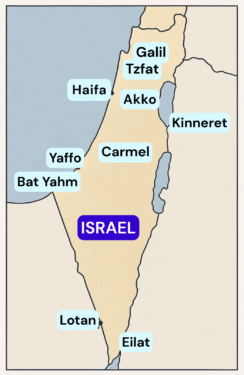Discover what your city is like in Israel!

1. Haifa
Haifa has a rich Jewish history as a hub of the Zionist labor movement and home to longstanding Jewish communities. It is Israel’s third-largest city, a major port, and an industrial and cultural center, also known for the international Baha’i Gardens. The city sprawls across the slopes of Mount Carmel and overlooks the Mediterranean coastline.
2. Kinneret
The Kinneret holds deep Jewish significance, appearing throughout the Torah and rabbinic texts and lying near ancient Jewish towns like Tiberias. It also serves as Israel’s largest freshwater lake and a vital water source, as well as a center for tourism and recreation. Resting in northeastern Israel, it is encircled by fertile hills and valleys, making it both a natural and cultural landmark.
3. Galil
The Galilee region became the heartland of Jewish life after the destruction of the Second Temple, where rabbinic Judaism flourished. Today, it is known for agriculture, wineries, and eco-tourism, drawing visitors to its open landscapes. This northern area of Israel is filled with mountains, forests, and fertile valleys, shaping it as a green and scenic region.
4. Akko
Akko is one of Israel’s oldest continuously inhabited cities, with a Jewish presence stretching back to biblical times and beyond. It stands out as a mixed Jewish-Arab city and is recognized globally as a UNESCO World Heritage site with Crusader and Ottoman heritage. Located along the Mediterranean coast, it is a fortified city with a historic port that once played a key role in trade and conquest.
5. Tzfat
Tzfat is revered in Judaism as one of the four holy cities, particularly for its role as the center of Kabbalah and Jewish mysticism in the 16th century. It has grown into an artistic and cultural hub, hosting galleries and music festivals. High in the Upper Galilee mountains, it is one of Israel’s highest and most picturesque cities.
6. Yaffo
Yaffo, mentioned in the Bible as a strategic port, has a long Jewish presence and became central during the early Zionist resettlement. It is now part of Tel Aviv, alive with markets, arts, and a diverse cultural scene. A Mediterranean port city, it blends its historic old town with modern urban neighborhoods along the coast.
7. Carmel
Mount Carmel carries Jewish significance from the biblical story of Elijah, who challenged the prophets of Baal on its slopes. It is treasured for its nature reserves, hiking trails, and Druze villages that dot the mountain. Rising above the Mediterranean, it forms a rugged coastal ridge overlooking Haifa and offering dramatic views and lush landscapes.
8. Bat Yahm
Bat Yahm began as a small Jewish town in the early 20th century and has grown into a vibrant urban community. It is recognized for its Mediterranean beaches and rapid urban development, with strong ties to Tel Aviv just to its north. A flat coastal city, it stretches along the shoreline and is defined by its seaside culture.
9. Lotan
Kibbutz Lotan reflects modern Jewish life, founded as part of the Reform movement and rooted in values of community and tradition. It is renowned as an ecological center, focusing on sustainability, organic farming, and environmental education. Situated in the remote Arava desert between the Negev and Eilat, it blends desert life with innovation.
10. Eilat
Eilat has ancient Jewish roots, linked to King Solomon’s port at Ezion-Geber, and remains a part of Israel’s southern story. It thrives as a resort destination, attracting visitors for its coral reefs, nightlife, and beaches. At Israel’s southernmost tip on the Red Sea, it is surrounded by striking desert mountains and serves as the country’s gateway to Africa and Asia.
